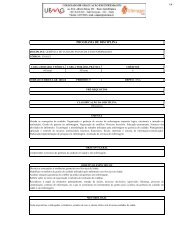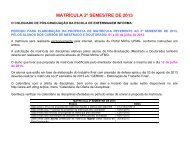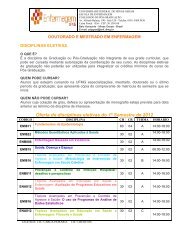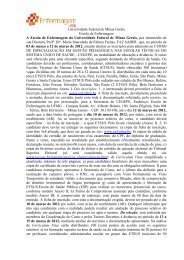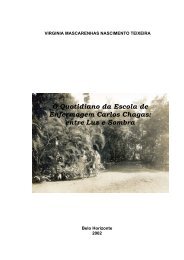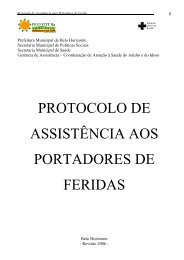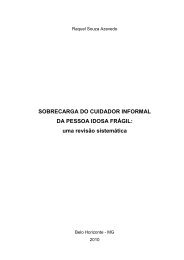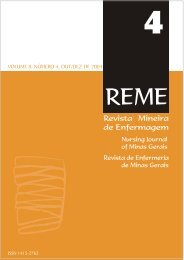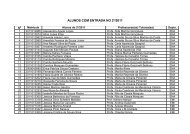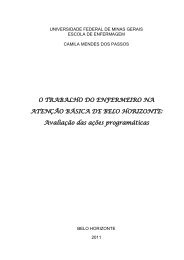versão completa em PDF - Escola de Enfermagem - UFMG
versão completa em PDF - Escola de Enfermagem - UFMG
versão completa em PDF - Escola de Enfermagem - UFMG
- No tags were found...
You also want an ePaper? Increase the reach of your titles
YUMPU automatically turns print PDFs into web optimized ePapers that Google loves.
Publication Norms1 - REME - Revista Mineira <strong>de</strong> Enfermag<strong>em</strong> is a publication of the School of Nursing of the Fe<strong>de</strong>ral University of MinasGerais/<strong>UFMG</strong>, in partnership with Nursing schools and courses in the State of Minas Gerais, Brazil. The magazine is issue<strong>de</strong>very quarter with the objective of contributing to the production, diss<strong>em</strong>ination and use of the knowledge produced innursing and other areas, covering issues related to teaching, research and assistance.2 - REME has the following structure: an Editorial; original articles, abstracts of theses and dissertations, reports ofexperience, updates and reviews; notes and information (updates in nursing and similar fields, research reports,abstracts and varied pieces of news); publication norms.3 - The papers are analyzed by the editors of REME, who have the right to accept or refuse the papers submitted.4 - The articles must be sent on a diskette, in "Word for Windows", version 6.0 or higher, "Times New Roman", size12, double space, in two copies printed on standard ISO A4 paper (212x 297mm), with margins of 25mm, standardletter or laser, limited to 20 pages, including title, text, acknowledg<strong>em</strong>ents, bibliography, tables, legends and illustrations.They must be addressed to REME with a cover letter containing the name of the authors, mailing address, e-mailaddress, telephone and fax numbers.5 - The first page should contain the title of the paper; names of the authors, with their highest acad<strong>em</strong>ic qualificationand institution; address for correspon<strong>de</strong>nce and financing agencies (in a footnote); abstract and key-words; the title,abstract and key-words should be in Portuguese, English and Spanish. The English and Spanish abstracts should comeat the end of the paper, before the bibliography. The abstract should be no longer than 100 words.6 - The drawings and graphs should be presented on tracing paper; photographs and/or sli<strong>de</strong>s numbered and in blackand White, indicating the place for insertion in the text; abbreviations, symbols, units and bibliography should followinternational norms of publication.7 - For the purposes of normalization, we adopt the requir<strong>em</strong>ents of the International Committee of Medical JournalEditors. These norms can be found in full in the following publications: International Committee of Medical Journal.Editors: Uniform requir<strong>em</strong>ents for manuscripts submitted to biomedical joumals; Can. Assoc. J. 1995; 152(9):1459-65and in Spanish, in the Bol. Of Sanit. Panam. 19899, 107 (5).422-31.8 - All papers should have the following structure and or<strong>de</strong>r:• title (with translations into Portuguese and Spanish);• Complete name of author (authors), followed by their profession and respective qualifications;• Abstract in Portuguese, no longer than 100 words;• Key-words (three to t<strong>em</strong>), according to the Medical Subject Headings (MeSH) of the In<strong>de</strong>x Medicus;• text: introduction, material and method or <strong>de</strong>scription of methodology, results, discussion and/or commentsand conclusions;• Summary in English (Abstract) and Spanish (Resumen), with the correct version for those languages;• Key words/ Palabras-clave (English and Spanish) according to the Medical Subject Headings I (MeSH) of the In<strong>de</strong>xMedicus; <strong>de</strong>scriptors of BIREME: www.bir<strong>em</strong>e.br;• Acknowledg<strong>em</strong>ents (optional);• Bibliography, as specified in it<strong>em</strong> 10;• Author’s address for correspon<strong>de</strong>nce.9 - Illustrations should be placed immediately after references to th<strong>em</strong> in the text. Within each category, they shouldbe numbered in sequence throughout the text. Example: (Tab. 1, Fig. 1, Graph 1). Each illustration should have a titleand its source. Headings and legends should be sufficiently clear and comprehensible, without the need to consult thetext. References to illustrations in the text should be mentioned between parenthesis, indicating the category andnumber of the illustration. Ex. (Tab. 1). Photographs should be black and White, coming in a separate envelope. Theyshould be sharp and with good contrast, on glossy paper and, on the back, they must inclu<strong>de</strong>: author’s name, title ofthe article and number for inclusion in the text.10 - The bibliography references will be numbered in sequence, in the or<strong>de</strong>r in which they are mentioned in the text.They must follow the norms of the International Committee of Medical Journal Editors mentioned in it<strong>em</strong> 7. Thetitles of the journals are abbreviated as in the In<strong>de</strong>x Medicus, in the publication "List of Journals In<strong>de</strong>xed in In<strong>de</strong>xMedicus", issued annually in January, in separate. The text references should be given in Arabic numbers, correspondingto the references at the end of the article. Bibliographical references should be quoted as follows:10.1 - JOURNALSa) Standard journal article. Inclu<strong>de</strong> the name of all the authors, when they are six or fewer. If they are seven ormore, quote the fist three, followed by et al.Nascimento ES Compreen<strong>de</strong>ndo o cotidiano <strong>em</strong> saú<strong>de</strong>. Enf Rev 1995; 2(4):31-8.REME – Rev. Min. Enf; 9(1): 89-96, jan/mar, 2005 91



